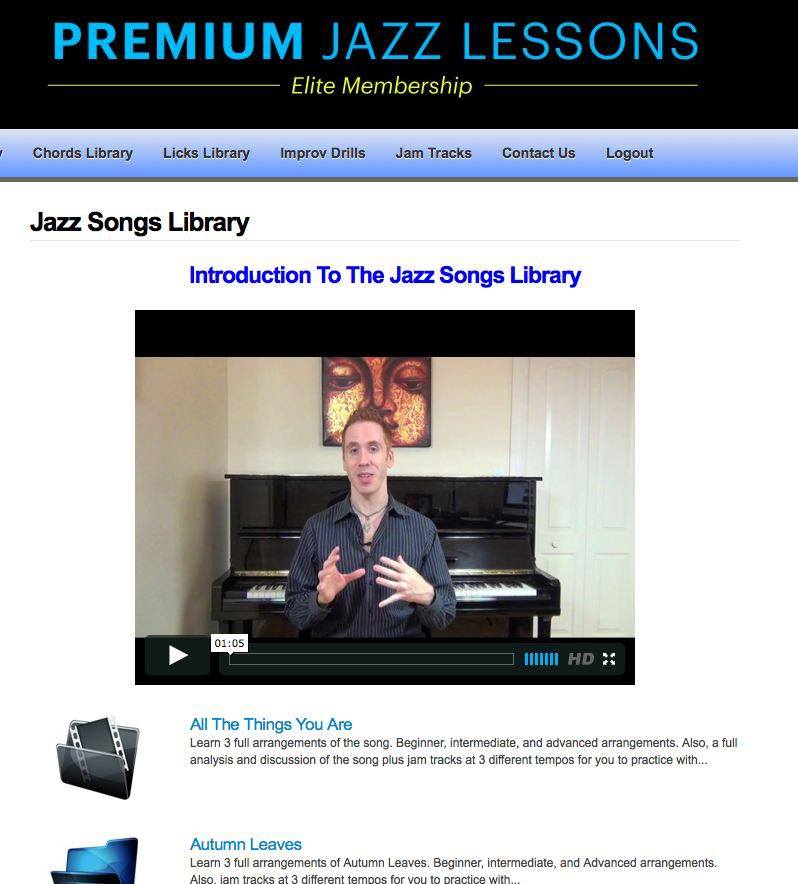Jazz Piano Practice Strategy Guide Part 1
 If you’re reading this lesson there’s no question that you have a love, a passion, and a commitment to learning jazz piano.
If you’re reading this lesson there’s no question that you have a love, a passion, and a commitment to learning jazz piano.
You and I have a lot in common in that way!
Part of my job, as an online jazz piano teacher, is to help keep you motivated and focused on your musical goals.
Now, I have to warn you before you go further into this article though.
This isn’t a “learn jazz piano in 5 minutes” lesson. If you’re looking for a quick fix with no effort you’ve come to the wrong place.
Learning to play jazz piano does require some time and commitment to the process of learning. 🙂
Fortunately, with the right kind of effort and practice strategy we can work together to achieve maximum success.
Results will definitely happen but you must practice in a smart way.
It’s very easy to waste time while your “practicing”. That’s why it’s important to focus on the type of activities in the practice room that will make the most dramatic impact on your playing goals.
If you’re going to sit down and invest your time into practice you should get results!
So, today I want to share with you a big picture concept that will provide some structure for your jazz piano practice routine.
I’ve seen a ton of success from the hundreds of students I’ve worked when they keep their focus on this concept I’m about to teach you.
Let’s get started…
The Powerful Role Of Jazz Tunes
When you first start learning jazz there can seem like an overwhelming amount of information to absorb (chords, licks, scales, reharmonization, soloing, chord progressions etc etc).
It’s easy to become so focused on all the technical details of the music that you lose site of what the big picture is.
So, how do you make sense of it all?
Well, the first step is finding a simple way to apply all the new concepts you’re learning.
What Is The Big Picture?
To put it simply, the big picture is made up of 2 simple things:
1. Mastering Jazz Tunes (Building A Repertoire).
2. Applying Any New Jazz Vocabulary You Learn To This Repertoire.
- If you learn a new lick throw it in a tune.
- If you learn a new chord voicing throw it in a tune.
- If you learn a new reharmonization throw it in a tune.
- New scale, new chord progession, new improv concept, etc…..throw it in a tune.
Quick Note
Now, in no way am I’m not saying that you shouldn’t spend time exploring different areas of the art form. Ideally you’ll be exploring as much as you can about the different aspect of playing jazz piano.
But, if you have limited practice time then there’s one area of jazz I would recommend you focus your practice time on first.
That area is learning and working on songs.
Spending time working on tunes will give you an incredible amount of impact for your time.
It will also give you the most measurable results for the effort you do put into your practice. Here’s why:
1. Simply put, It’s incredibly fun to play and learn songs. There’s a reason why the songs we’re learning are called standards. They’re so popular that people have been playing many of them for decades.
2. These songs are incredibly well written and have great melodies and great chord changes that have stood the test of time. We’re playing some of the best songs ever written. You can’t beat that recipe.
3. Add in a lot of the cool chord voicings, rhythms, and reharms I teach you (or you’ve picked up elsewhere) and you’ve got a killer formula for making great music.
Sharing Your Music
A lot of readers of this site have told me they love to share their music in public. Either with friends, family, Youtube, or on gigs. I’m always so happy to hear that because I love doing that too!
If you’re going to try and share music with an audience why not really try to connect with them?
So, here’s the thing. After playing over 1500 live gigs and sharing music with hundreds of thousands of people through this site, I’ve notice that overwhelmingly people react the most when I play standard tunes that they recognize.
So, when you play tunes people know and play it with good groove and a great arrangement people LOVE it. Their faces light up.
(That was my formula for example when I created this Herbie Hancock chords lesson)
Now your audience may not know a thing about any of the hip voicings you throw in or what a II-V-I chord progression is though. They really don’t have to.
They can feel them and relate to them if you put them in context with a great melody and rhythms that are fun to listen to.
If you’re playing famous standards with a great swing feel then you’ll be achieving all these goals here.
Great tunes, great groove, great arrangement. It’s a winning strategy and a great way to share your talent and hard work with your audience.
Think of jazz greats like Keith Jarrett, Oscar Peterson, Barry Harris, Bill Evans, and Fred Hersch, They’re all famous for communicating with an audience through standards.
They’re clear on the way they communicate with an audience. We should be too.
Clear Is A Beautiful Thing
 Speaking of being clear. Lets talk about goals for a quick second.
Speaking of being clear. Lets talk about goals for a quick second.
When you sit down to learn a song you’re focusing on a very clear goal. It’s a tangible result and something that is understood and very easily achievable.
Clarity is a beautiful thing when it comes to musical goals. So, playing tunes is also great for clear goal setting.
What’s Inside You?
Over the course of the next 6 months to a year you can easily set a goal of learning 10-15 pro level jazz piano arrangements.
A small commitment like this can pay huge dividends. It will completely change your musical life.
Take a moment and imagine what it will feel like to be able to play 1-2 full sets of pro jazz piano arrangements.
- What kind of impact will it have on your life?
- What will it do for your sense of creativity?
- Your sense of happiness and joy?
- Your sense of personal accomplishment?
Anything is possible with the right focus and strategy.
Help Learning Jazz Tunes
Speaking of learning tunes. If you’re great at learning by yourself you can check out my Here’s That Rainy Day Tutorial or this jazz piano tutorial.
Are you not comfortable learning pro level jazz tunes by yourself yet?
If you want more step by step instruction, there are tons of song tutorials inside my Premium Jazz Piano Lessons Membership Course.
What’s Coming Next
Now that we have established how important focusing on tunes is. In a few days I’ll be releasing another practice guide.
I’m going to teach you a lot of the special strategies that I use to learn tunes quickly. I get gig calls all the time where I have learn a whole album of music in just a few days.
I’ll teach you a lot of the strategies I use to help me achieve this. In the meantime, I want you to do 2 things:
1. Take at least 1 hour and really dive into learning one new tune. Get in to the melody, the chords, the groove, you name it.
2. Enjoy playing the piano.
See you again in a few days.
With Gratitude,
Steve “Practicing Tunes” Nixon
P.S. If you have any questions about today’s lesson please leave a comment below. I’m happy to help in any way that I can.

